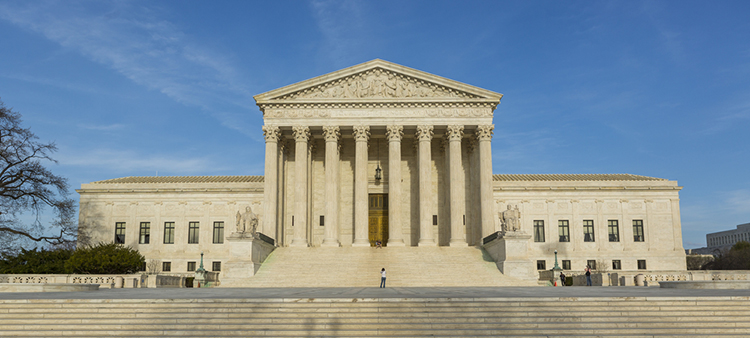Supreme Court considers Trump's plan to adjust census based on immigration status

Image from Shutterstock.com.
During President Donald J. Trump’s four years in office, challenges to one administration policy after another eventually reached the U.S. Supreme Court. Trump won some and lost some.
With the election of former Vice President Joseph R. Biden Jr. to the White House, those Trump battles are near an end. But there are still three pending cases before the justices involving Trump initiatives. Two of those have not yet been scheduled for argument and may fizzle if the new administration moves quickly to change policies.
One involves a policy known as Migrant Protection Protocols, in which immigrants from Central America who passed through Mexico to reach the U.S. border have been returned by U.S. authorities to Mexico while their removal proceedings are pending. The other involves a challenge to the Trump administration’s use of some $2.5 billion in Department of Defense funds to build parts of a border wall with Mexico.
A third Trump administration action is going before the high court Monday, even as the election of Biden and other developments raise questions about whether the justices will reach the merits of the case. But the case, for now, raises the specter that the outgoing president will be able to put a stamp on decennial census numbers and the apportionment of Congress that could benefit Republicans for a decade.
In Trump v. New York, the central question is whether the president has the authority to exclude immigrants living here illegally (or “illegal aliens,” as the Trump administration calls them), from the base population number of the 2020 census that is used for the apportionment of seats in the U.S. House of Representatives.
“No president has tried to do this before,” says Margo J. Anderson, a professor emeritus of history at the University of Wisconsin-Milwaukee and the author of the 2015 book The American Census: A Social History. “This hasn’t been something historians or legal scholars have really worried about.”
‘It is the policy of the United States …’
In 2019, the Supreme Court blocked the Trump administration’s intention to ask a question about citizenship on 2020 census forms. Soon after the decision, Trump issued an executive order directing federal agencies to use administrative records as best they could to determine citizenship data about the population.
In July 2020, well into the operation of the census, the president issued the memorandum at issue in the case. The memo said that for “the purpose of the reapportionment of representatives following the 2020 census, it is the policy of the United States to exclude from the apportionment base aliens who are not in a lawful immigration status … to the maximum extent feasible and consistent with the discretion delegated to the executive branch.”
The memo directed Secretary of Commerce Wilbur L. Ross Jr. to provide two sets of numbers to the president by Dec. 31 of this year. One would be a total based on the Census Bureau’s “residence criteria,” which sought to count people at their usual residence. The second set of numbers would permit the president to carry out a policy of excluding unauthorized immigrants from the apportionment base that Trump must report to the new Congress by Jan. 10, 2021.
The Trump memorandum was challenged in multiple lawsuits around the country, including by some of the same adversaries that had sued over the citizenship question—a group of states and cities led by New York state and a coalition of immigration groups represented by the American Civil Liberties Union.
“What President Trump is proposing to do is unconstitutional and contrary to [statutory] law,” says Sarah Brannon of the ACLU’s Voting Rights Project. “The Constitution is very clear that the intent of the founders was for the census was to be broad and inclusive. This is about where people reside in the usual course, and legal status is not a relevant factor.”
New York state, in its merits brief, points out that the Constitution requires apportionment based on all “persons in each state.”
“The drafters explicitly carved out specific exemptions from this broad language (slaves under the three-fifths clause and Indians not taxed) but said nothing about immigration status or any other legal status,” the New York brief says.
One expert predicted that if unauthorized immigrants are excluded from the apportionment tally, Texas would almost certainly lose a congressional seat, and California and New Jersey would each likely lose a seat. Pew Research Center predicts that if Trump’s plan is carried out, Alabama, Minnesota and Ohio, which have smaller immigrant populations, would each hold on to a seat they would otherwise lose.
A special three-judge federal district court in New York City ruled that the president’s memorandum violates two federal statutes because it would base apportionment on something other than the actual enumeration of the census as well as congressional directives to base apportionment on “the whole number of persons of each state.”
In related suits, three-judge federal district courts in California and Maryland have ruled against the president, with the court for the Northern District of California also ruling that the plan violated the Constitution.
The Trump administration argues in court papers that “it has long been understood that, under the governing legal provisions, the phrase ‘persons in each state’ means ‘inhabitants’ (or ‘usual residents’), and vests discretion in the executive branch to ascertain how that standard applies to particular categories of persons with debatable ties to a state.”
Acting U.S. Solicitor General Jeffrey B. Wall adds in the brief that, “Here, there is ample historical and structural evidence supporting the president’s policy determination that the standard need not include all aliens living within a jurisdiction without the sovereign’s permission to settle there.”
John S. Baker Jr., a professor emeritus at Louisiana State University Law Center, argues that modern-day uses of census data to distribute billions of dollars in federal funding to the states and local governments has obscured the constitutional purposes of the census to count all “inhabitants” for the purpose of apportionment and ultimately the distribution of votes in the Electoral College.
The funding purposes have become “the tail that wags the dog,” says Baker, who filed an amicus brief in support of the Trump administration that argues that all foreign nationals, including unauthorized immigrants, are not inhabitants and should not be included in the apportionment number. (Lawful permanent residents, known as green card holders, do count as inhabitants, everyone seems to agree.)
Numbers anxiety
Anderson, the University of Wisconsin-Milwaukee professor, joined a brief in support of the challengers filed by historians of the census. The brief argues that original founding-era principle of an inclusive census has repeatedly been reaffirmed by Congress, in the 14th Amendment and in census statutes.
“There is a much bigger issue that goes to what we use the census for,” says Anderson, who adds that the Trump plan “raises issues about trust of the census, voluntary response options and suspicion of government.”
Anderson is dubious that administrative records provide the federal government with reliable information about the number of immigrants in each state living in the country illegally.
“The federal government does not produce official numbers of undocumented immigrants,” she says. (One conservative estimate of the number is 10.5 million, or about 3.2% of the population.)
The Trump administration seemed to hedge a bit on whether the Census Bureau can come up with a number. The brief quotes a bureau press release in October that said: “A team of experts are examining methodologies and options to be employed for this purpose.”
“That process continues,” Wall says in the brief, “and the ‘bureau does not know exactly what numbers the secretary may report to the president.’”
On Nov. 19, Census Director Steve Dillingham added to the cloud of uncertainty around the case with a statement that said during post-collection processing of census data, “certain processing anomalies have been discovered.”
The Washington Post reported some Census Bureau staffers had told the Commerce Department that the apportionment numbers would not be ready until at least late January. Dillingham’s statement said, “I am directing the Census Bureau to utilize all resources available to resolve this as expeditiously as possible. As it has been all along, our goal remains an accurate and statistically sound Census.”
The solicitor general’s office, in its reply brief filed with the court Nov. 23, did not address the possible delay or the potential impact of the change in administration with Biden’s election.
Brannon of the ACLU says there is no confirmation the Census Bureau will miss the Dec. 31 deadline for delivering apportionment numbers to Trump. It appears the Nov. 30 argument will proceed as scheduled.
“We feel there is a necessity to put forward our case,” Brannon says.



